Note: This website was automatically translated, so some terms or nuances may not be completely accurate.
What new hints for added value did this century-old senbei shop discover by looking through the lens of "desire"?

Midori Takei
Chuo-ken Senbei Co., Ltd.

Takashi Chiba
Dentsu Inc.
DENTSU DESIRE DESIGN (DDD) is a project that seeks to unravel the modern consumer profile, which has become increasingly elusive to companies, by revisiting consumption consciousness rooted in "Desire."
DDD offers the "Heart-Moving New Product Development Program, " designed to "concretize the 'desires' deep within customers' hearts and fulfill them." This program accompanies new product development from the consumer's desire perspective, based on the 11 new modern "desires" identified through DDD's activities and the real voices of approximately 20,000 people gathered in the database from its regularly conducted "Heart-Moving Consumption Survey."
In August 2023, a product development project utilizing this program commenced at Chuo-ken Senbei, a century-old rice cracker shop celebrating its 100th anniversary. Following preliminary input and workshops involving DDD members, the new product "Dip-Style Rice Crackers" was born in just about 10 months.
Following our previous article featuring a roundtable discussion with workshop participants, this article presents interviews with Midori Takei, Managing Director at Chuo-ken Senbei, and Takashi Chiba of DDD.
We delve into the challenges faced by this century-old company, the DDD program and approach that addressed them, and the story behind the new product development that "moved the participants' hearts."
■For details on the project's specifics, please see here

<Table of Contents>
▼Transforming the Product Development Process to Move Beyond Product-Centric Thinking
▼The "This is it!" Moment of Discovery
The "11 Desires" and Desire Clusters: Logically Representing Existing Customer Perceptions
▼Workshops with Participation from All Departments. A Dense, "Fun" Day Generates 49 Ideas
▼"Shifting Half a Step" from Existing Perceptions Creates Curiosity-Inducing "Discomfort"
▼Good Products Aren't Born from Logic Alone. "Grounded Delusions" Expand Ideas
▼We Want to Focus on Enabling Natural "Movement" Rather Than Forcing "Action"
Transforming the product development process to break free from a "product-centric" approach
──First, we'll ask Mr. Takei. Having sustained a "100-year business" since your founding in 1923, how has your company's product development been conducted until now?
Takei: At our company, the "Product Department" handles everything from marketing to overall development. We also have a unique feedback sheet designed by our direct-sales store staff to capture customer voices and requests. Especially when launching new products or revamped seasonal items, we collect candid impressions to inform development.
Chiba: The store staff participating in the project also mentioned that they consistently prioritize listening carefully to customer feedback. It seems you've always been diligent about thoroughly gathering needs.
Takei: Yes. However, the feedback gathered this way tended to focus relatively more on "functional" aspects. While we certainly receive many comments like "The taste was excellent," the specific improvement points for products often centered on factors affecting ease of purchase, such as price range, quantity, or box size. Finding hints for new added value was quite challenging.
──When developing products based on customer needs, did you also tend to focus more on functional aspects?
Takei: Yes. We inevitably started from the "product" itself, and feeling the need to change the product development process itself was the starting point for our consultation.
Simultaneously, as a business challenge, the gift market—our core focus—had undergone significant changes over the past decade or so. The trend was shifting away from traditional gifts like O-chugen and O-seibo towards more personal/casual gifts. Amidst growing demand for gifts orderable via digital services, we sensed the very nature of value expected from gifts was changing.
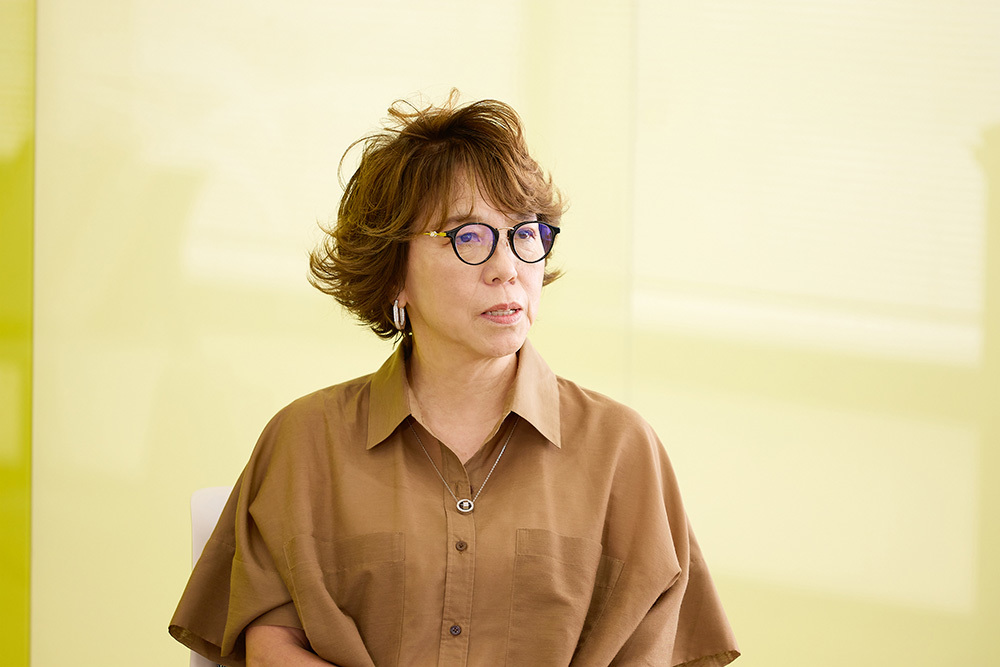
Takei: Amidst these trends, we undertook various challenges. Rather than focusing on hit products within the gift market, we developed "Risocotti" – a rice-based biscotti – as a new product aimed at the global market. However, breaking away from the traditional product development process, which inevitably starts with the "product" itself, remained difficult.
The moment we found it, we knew: "This is it!" The "11 Desires" and desire clusters logically represented the image for existing customers
──What prompted you to approach Dentsu Inc.?
Takei: How to get younger generations to choose "okaki" and how to create new opportunities became major themes within our company. However, identifying the necessary added value and customer needs was difficult through our own analysis alone.
We wondered if there might be existing expert classifications of consumer types and needs we could use as a starting point. While exploring related information, we discovered details about DDD's "11 Desires" on the Do! Solutions website. The moment we found it, we thought, "This is it!" We downloaded the free materials, received a follow-up contact, and mustered the courage to attend a consultation session—that's how the project began.
Chiba: I joined from that very first consultation session. The product development program we implemented this time was already nearly complete at that point. We hadn't released it publicly yet, but after hearing your story, I thought it was a perfect fit for Chuo-ken Senbei's situation.
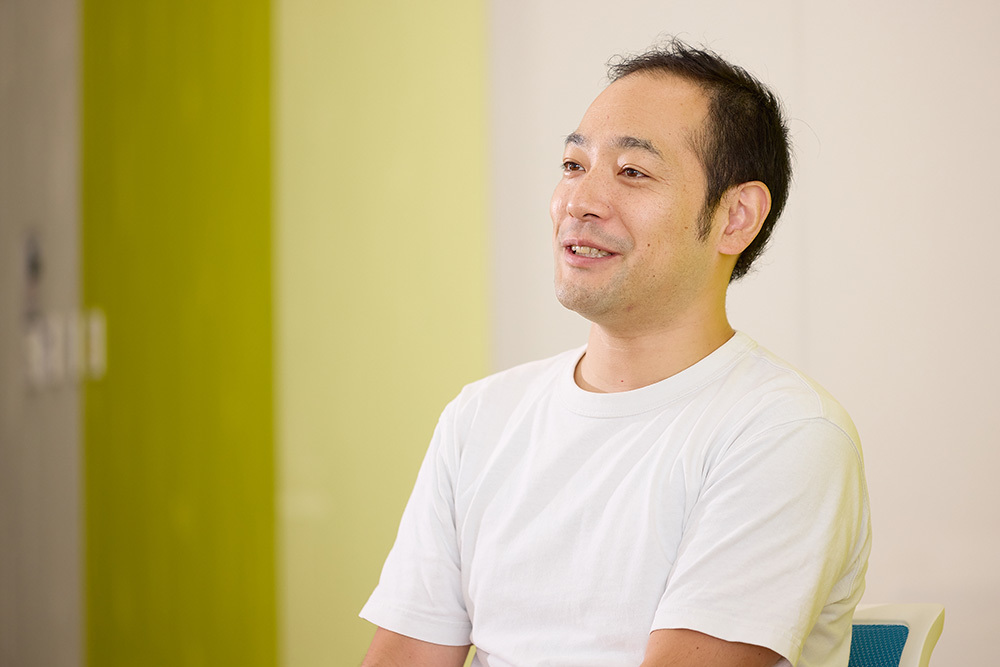
──So the timing aligned perfectly with DDD's actions too. After hearing about it at the consultation session, what were your thoughts, Chiba-san, regarding Chuo-ken Senbei's challenges and potential strategies?
Chiba: About two days after the meeting, I actually visited the store and bought some products. Senbei crackers are something people of all ages can enjoy. Yet, I wondered why that wasn't being communicated. When I visited the store, it was exactly the "senbei shop" I had imagined, which was very reassuring. On the other hand, I felt that reassuring atmosphere wouldn't be enough to make someone who just happened to pass by stop and enter.
When considering new products here, I felt it's crucial to create a sense of "discomfort" within the senbei and formal gift categories. Mr. Takei expressed a desire for the appeal of senbei to be properly understood by the younger generation, specifically those in their 30s and 40s. Being part of that target demographic myself, I strongly felt this age group needs that "discomfort" to trigger their interest.
──Mr. Takei, you mentioned earlier that when you found the DDD information, you thought "This is it!" Did you immediately grasp the concept of the "11 Desires"?
Takei: Yes. The explanation of the "11 Desires" and the "Desire Clusters" was well-organized and easy to grasp. While I didn't fully grasp the Clusters due to time constraints, they were personable archetypes, so I could easily visualize them. I also recognized them in our existing customers, thinking, "Oh, we have people like that."
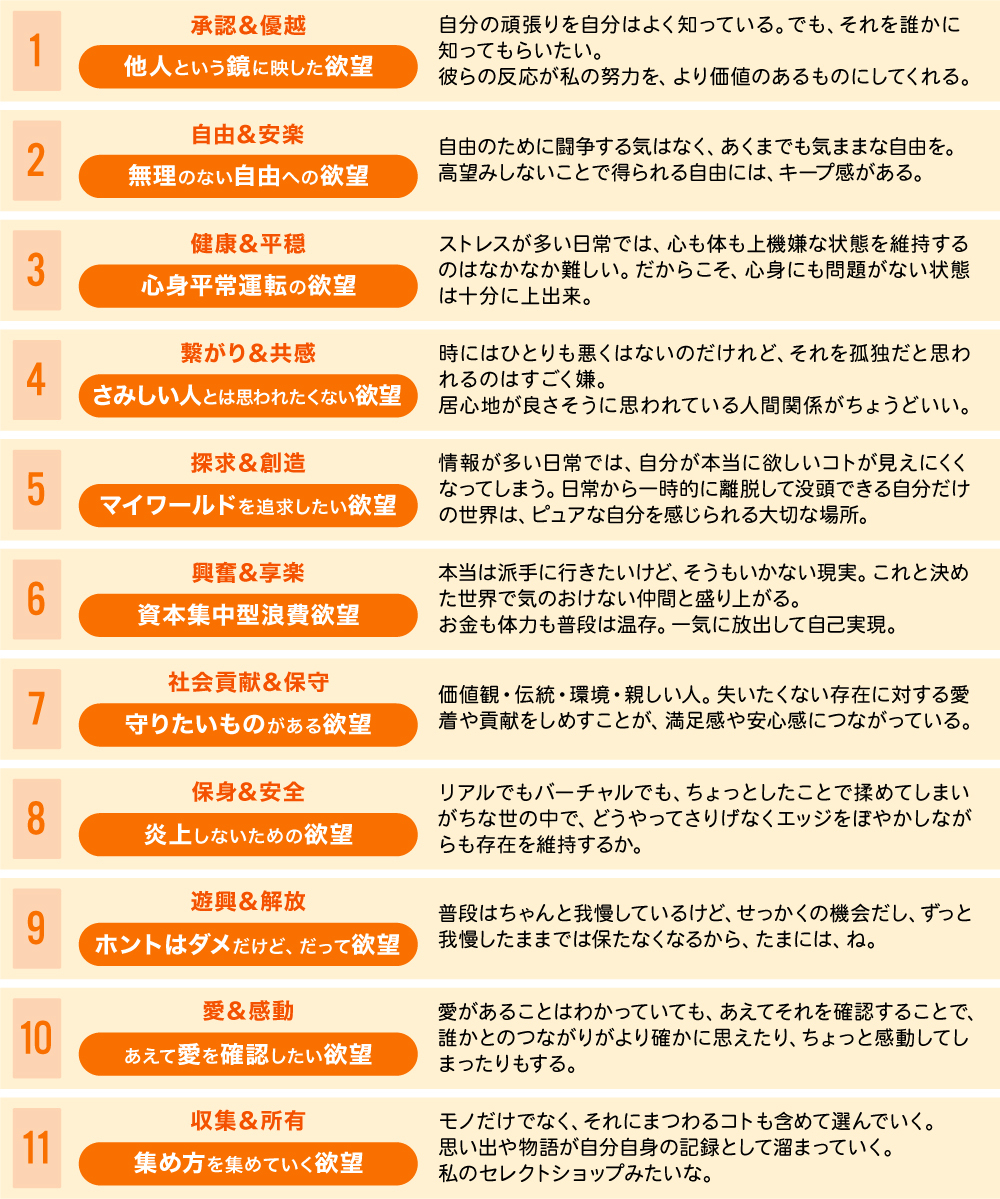
Chiba: At Chuo-ken Senbei, the store staff meticulously list every visitor. While that's wonderful, it inevitably relies heavily on human effort. So, we provided information that allows them to logically grasp that aspect. I felt it was crucial for this to align with what they intuitively felt was right.
Also, for this project, I felt it was easier to develop products by focusing on how to satisfy the underlying "desires" rather than categorizing people into clusters. While the desire clusters are typologies based on combinations of the "11 Desires," starting from this point risks discussions like "this cluster isn't our target."
Instead, I believed it was better to ground our thinking in the "desires" themselves and discuss, "Could this reach this person? Could it reach these people?" That's why, in the pre-input session ( ), I focused the explanation on the "11 Desires." While the program structure exists, I want to be flexible with such arrangements depending on the companies we collaborate with.
A workshop with participants from all departments. A dense, "fun" day that generated 49 ideas
──What criteria were used to select members for the workshop?
Takei: Traditionally, product planning is handled by the Product Department. However, when we decided to develop a new product with Dentsu Inc., we resolved to make it a company-wide, cross-departmental project. One reason was that in our annual "work satisfaction" survey, multiple voices from other departments expressed a desire to participate in product planning, so we wanted to try it.
Simultaneously, we wanted to foster an organization where everyone works toward the same goal, leveraging their individual strengths and roles while building a sense of solidarity. Therefore, a total of 12 members participated, drawn from Manufacturing, Sales, Marketing, Planning, and Promotions.
Chiba: For the project, we first selected four desires out of the eleven to focus on as our themes. For each desire, we had 600 to 1000 free-response comments (hereafter FA) from people who felt fulfilled through consumption. This time, we used 100 to 200 of those. We had all participants read these FAs. It was quite a demanding homework assignment, but we asked everyone to read them all and find comments they thought were good.
Takei: It was hard work, but really interesting. Reading them from the perspective of "What emotion is this?" or "What moved them?" completely changed how we saw things and led to new insights.
Chiba: Everyone really read them thoroughly! The key point of this "homework" was imagining the background: why did the respondent's heart feel fulfilled by each specific consumption? Why did they cite that particular product or service as something that moved them?
For example, if the underlying desire was "a yearning for freedom without strain," people of completely different genders and ages answered that they felt fulfilled in their desire for freedom through entirely different things. Despite these being completely different consumption behaviors, the workshop's theme was to find the common desire being fulfilled and summarize it in the form of a "desire hashtag."
For this, it was crucial that everyone thoroughly completed their homework. Another key point was that even with the same FA, people imagined different backgrounds, which became central to our discussions. I believe the discussions were so lively from the start precisely because everyone approached the task with such enthusiasm. We packed a volume that would normally require two days into just one, but it was truly great that everyone enjoyed working on it.
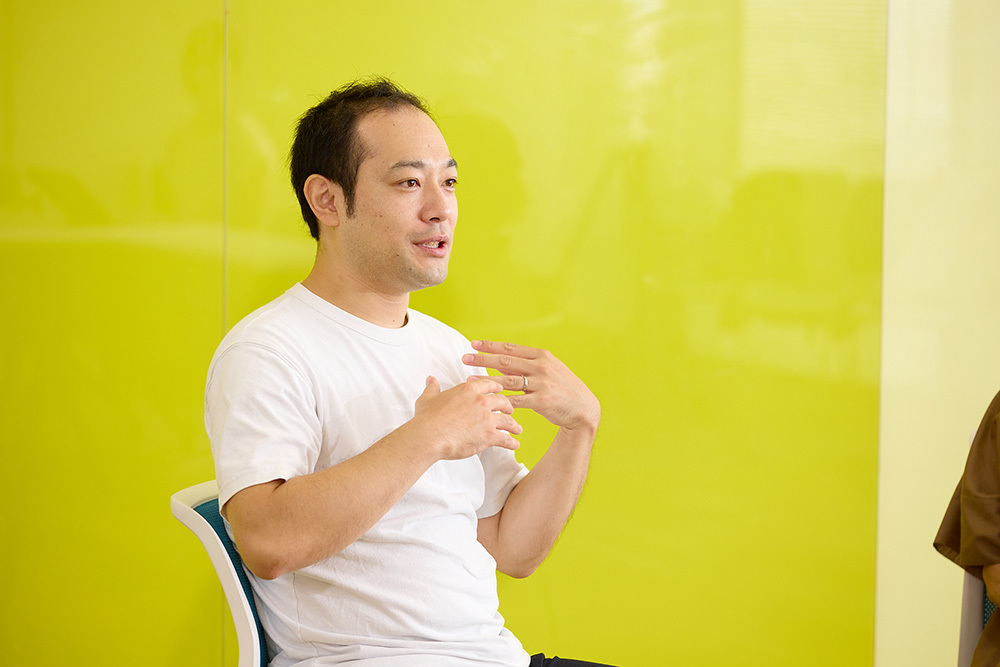
Takei: We're grateful to Dentsu Inc. for sending so many participants and providing such strong support and environment. Seeing everyone work with smiles all day in such a bright, fun atmosphere made me feel it was truly worth doing.
Chiba: Starting from brainstorming desire hashtags in the morning all the way to creating new product idea sheets, we ultimately generated 49 ideas in a single day. While our DDD team specifically disregarded development difficulty and feasibility, even considering those factors, the ideas were remarkably diverse.
Shifting just half a step from existing images creates that intriguing sense of "discomfort" that sparks curiosity.
──What ultimately decided on "dip-style rice crackers" from the 49 ideas?
Takei: It was the idea that "it allows people to rediscover the essential deliciousness of rice crackers."
A DDD member suggested, "Since the rice crackers themselves are already delicious, adding extra value could elevate the product further." We agreed that was the most important factor and made our decision. We thought the sauce could help enhance our rice crackers even more.
──What kind of support did Dentsu Inc. provide for commercialization?
Chiba: We didn't discuss specific product details. Instead, we focused on questions like "Who is this product for?" and "How can we best communicate this product in stores?" At that stage, we were conscious of finding that "half-step" departure from the "traditional rice cracker shop" image—meaning not straying too far, but venturing into a slightly challenging territory.
The "dip-style rice crackers" are primarily developed under the "Kirinosaka" brand within Chuo-ken Senbei. We worked closely to explore how we could shift just "half a step" from the established Kirinosaka brand image. We aimed to create clear, shared language for the concept, statement, and worldview—specifically, defining "the scenarios where people would enjoy this product."

Chiba: Since we were considering expanding this product's reach and holding new pop-up events, I also attended interviews with store managers. What struck me was that Chuo-ken Senbei already embodied the philosophy behind this program's theme, "Moving Hearts," both in their products and customer service. We prioritized imagining how people with that spirit and dedication would sell it, then determining what kind of product it should be.
Takei: That time was incredibly valuable for the sales staff too. It revitalized their customer service mindset. Every month, the sales staff meet to discuss and work on how to provide service that makes customers think, "I want to see them again." So, it was a great catalyst.
Good products aren't born from logic alone. Expanding our "ideas" requires "grounded imagination."
──Was there a difference in your approach to product development compared to when you were thinking from a "product" perspective?
Takei: It was completely different. Having employees from every department collaborate on development through workshops made "heartfelt connection" a company-wide keyword. The shared understanding that emerged in every process – "Will this truly move people?" "Can we really create such a product?" – was immensely significant.
It shifted our development mindset away from focusing on "what we can do" or first identifying "what we can't do," toward thinking about how to make things happen. This approach feels like it greatly expanded our possibilities.
──Did the hearts of those involved also move a little?
Takei: I believe it has, very much so. Previously, our company was deeply focused on "manufacturing," with a strong emphasis on quality. As we approached our 100th anniversary, we set the vision to move beyond that stage: "From a manufacturer of products to a team of creators who bring smiles."
This product development project truly embodied that vision. I believe every participant felt that creating smiles and "moving our customers' hearts" was a central theme.
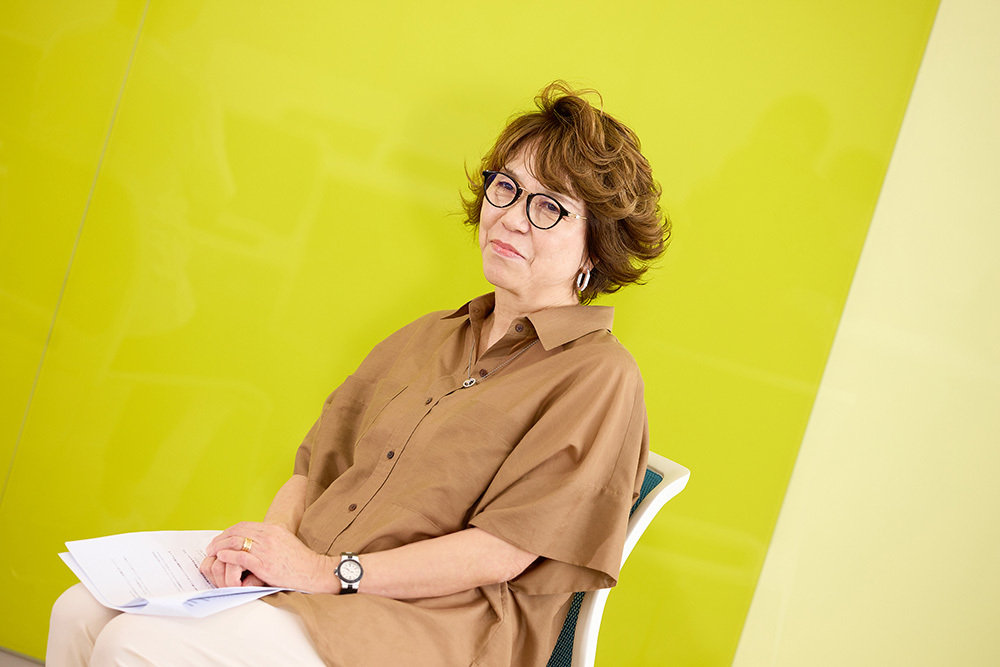
──Chiba-san, having completed this as the first case study of the "Heart-Moving Product Development Program," what insights did you gain?
Chiba: Among the 49 ideas, some were undoubtedly similar to proposals we'd considered before. However, what was crucial this time was that these ideas were born from a foundation of "desire" – they were thoroughly thought through, considering exactly what emotions we wanted the purchaser to feel.
Product development always requires "ideation," so you can't build a foolproof logic. In fact, products solidified solely by logic tend to be less appealing and don't sell well. But I was reminded that the ability to create a rationale within the development team—or rather, a "grounded fantasy"—is crucial for bringing something new into the world.
Rather than trying to "move" hearts, I want to focus on creating things that naturally "move" people.
──Please share your outlook for the future.
Takei: One challenge before implementation was that product planning was overly dependent on specific individuals. Establishing this as a solid "process" for product development was also a personal challenge for me, and I feel we've taken that first step. Moving forward, I believe it's crucial to "systematize" this flow.
I also truly felt the immense impact of shifting perspectives. Over time, we can become limited by our own accumulated experiences and define our own "capabilities." However, working with Dentsu Inc. reaffirmed that the products we create hold infinite potential. While the concept of "moving hearts" was key this time, I believe that once you shift your perspective, the scope of possibilities becomes entirely different.
Chiba: Throughout the entire process, we enjoyed ourselves, and everyone who participated seemed to be having a great time too. Honestly, I think that aspect was the most important.
It's not just about generating ideas and stopping there. To develop a product, sell it, and ultimately bring joy to customers, you need motivation that sustains you through the entire process. That's why making the idea-generation phase enjoyable is so crucial. I think it was significant that the members who shared the common memory of "That time was fun, wasn't it?" were able to work so hard right up until the product launch.
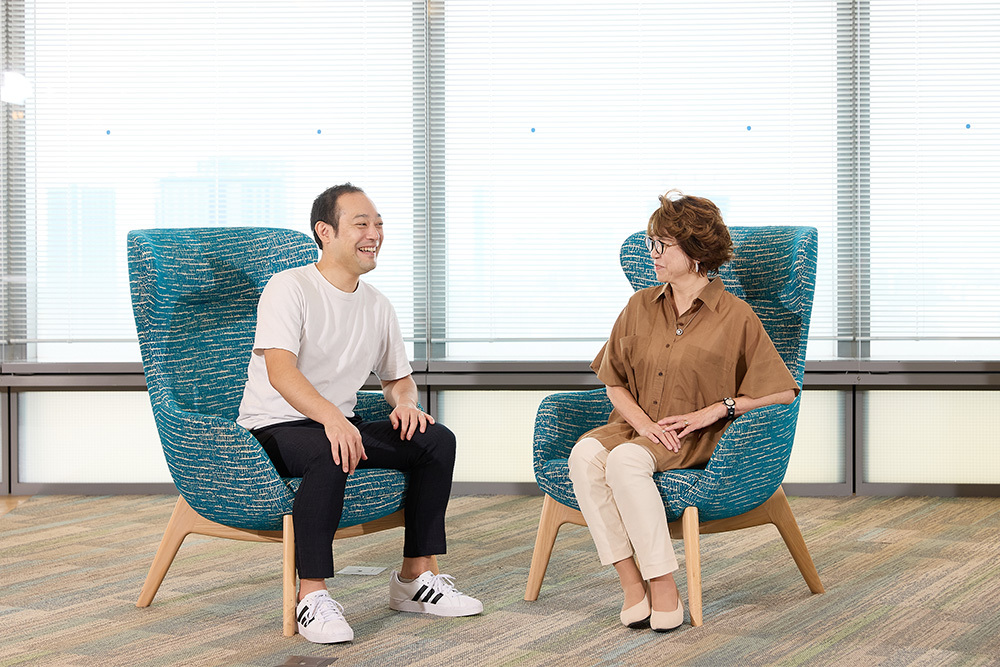
Chiba: As reflected in the program name, both DDD and I personally value the phrase "consumption that moves the heart." It's not about being "moved" or "moving" the customer's heart, but rather the heart "moving" itself. We always believe it's vital for the heart to move based on one's own desires, not just being influenced by something external. If you're interested, we'd be delighted if you'd feel free to contact us.
[Contact DDD Here]
E-Mail: ddd-project@dentsu.co.jp Contact: Chiba
Was this article helpful?
Newsletter registration is here
We select and publish important news every day
For inquiries about this article
Back Numbers
Author

Midori Takei
Chuo-ken Senbei Co., Ltd.
Product Department
Managing Director / General Servant Leader
After serving in roles including import sales operations, product planning, and research and development for California-based Amsnack, Inc., he currently works in the Product Department handling marketing, product development, sales promotion, and digital business operations.

Takashi Chiba
Dentsu Inc.
Future Prediction Support Lab
Producer
After working in sales, digital, and television departments, he was seconded to DENTSU SOKEN INC. There, he oversaw general social research and focused on themes like "regions and sports" and "the future of media," drawing on his past experience in sports and media. Returned to Dentsu Inc. in 2022, joining the Future Forecasting Support Lab / Future Business Creation Lab / Consumer Research Project DENTSU DESIRE DESIGN, which helps clients create future corporate value. Joined SPORTS TECH TOKYO in 2023.




